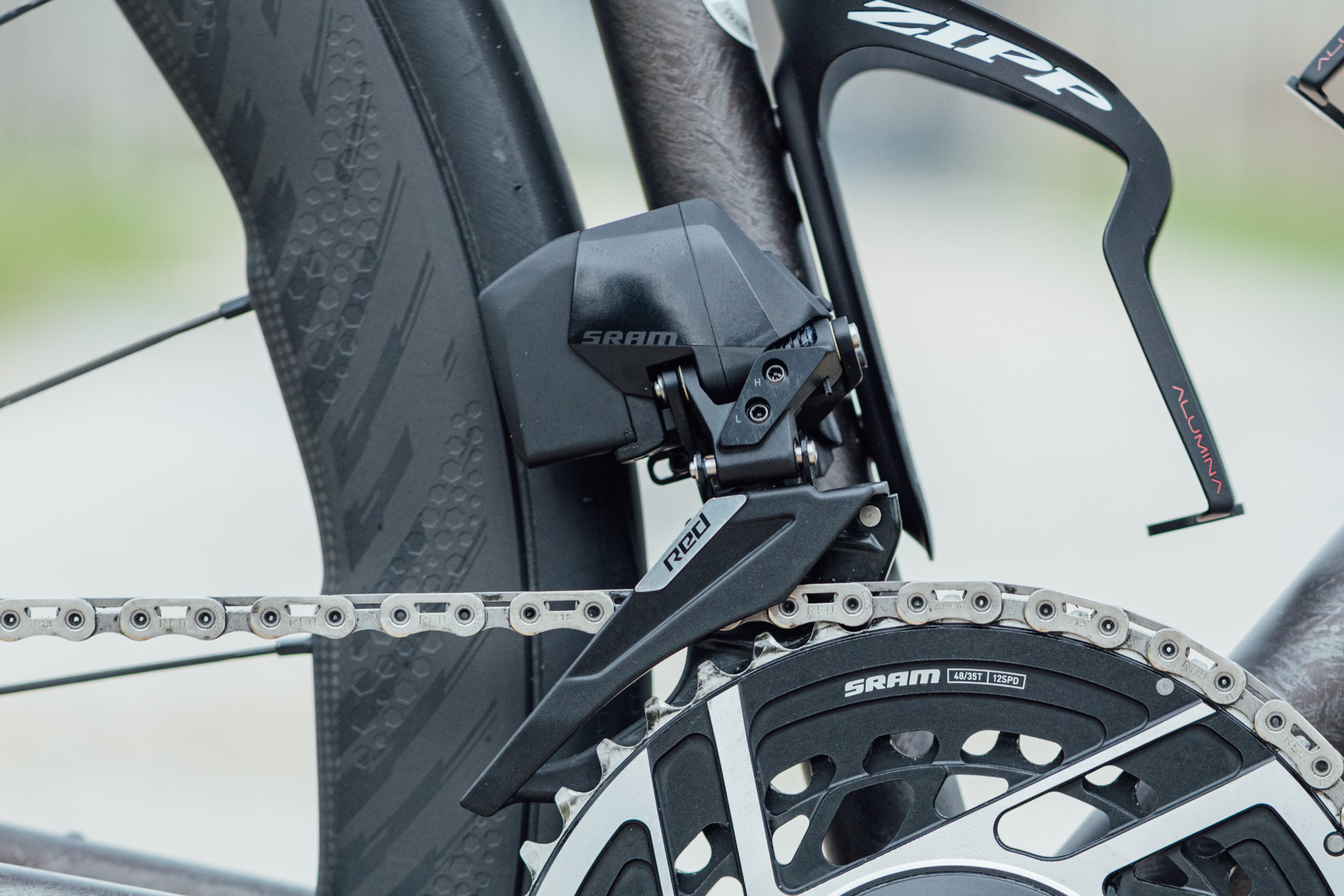
Price: $4,200 with power meter chainset.
Total weight: 2496 grams
Power Meter: Yes, spider mounted
Drivetrain options: 1x or 2X - 12 speed
The new Sram Red AXS groupset is officially here, though it has been on show in the run-up to its official launch date at the Giro d'Italia, La Vuelta Femenina and a few other races. Nevertheless, here we are, the official launch day of Sram's top-tier road groupset.
There's a lot to discuss with the new groupset and you can find a full breakdown of all components including weights and prices in our Sram Red AXS news piece.
So what's new? Well, after several years Sram Red has received a big update, there are new shifter ergonomics and shift buttons, plenty of weight saving, braking updates as well as some fresh new aesthetics.
Sram has also released three other new products today alongside the groupset two of which are designed to integrate with it. Head to our Red AXS news piece to read about them. The first and most relevant to this review is a new Hammerhead Karoo smart computer. (Hammered was acquired by Sram at the very end of 2021.)
The new Karoo which won't receive the 'Karoo 3' name badge a lot of us were expecting will ship with all groupsets to start with and top-end bikes specced with Sram Red AXS will come with a new Hammerhead Karoo computer, this is included in the price of a groupset. This isn't optional at the moment, and whilst I've gotten on well with testing the Hammerhead computer, I suspect it may be a contentious point for some.
I attended the launch of the new groupset in Italy back in March and have been testing it out since then at home. I've spent plenty of time riding the new groupset and am ready with my full review. A full Red AXS groupset with a power meter chainset option specced comes in at $4,200. This means it now sits in between Dura-Ace and Super Record WR price-wise, the other top offerings from the big three groupset manufacturers, but does the performance justify the price tag?

Design and Aesthetics
Aesthetically, Red AXS is all gloss carbon fibre and polished aluminium. The new groupset features a little more silver here and there to go with the carbon than the outgoing one. I think visually the biggest and most obvious changes come from the gear shifters and the rear derailleur.
The shifters have undergone a fairly dramatic transformation and are easily recognisable compared to the old units. They are longer and slightly smaller but also feature a more curved, slightly flared brake lever shape and the new square 'bonus buttons' on the shifter insides. Comparisons to Shimano GRX di2 will be made I think, but up close, there's a fair amount of difference. After seeing the new lever shape on a few different bikes including WorldTour setups I think it looks bang up to date and pretty futuristic.
The rear derailleur has a lot more silver finishing as mentioned and the large cutout in the main body draws the eye easily, the most obvious place for a prominent logo has been removed, an insight perhaps into the purpose behind Red AXS - performance. On the subject of logos, one small point, but one that bothers me slightly is the mismatched 'Red' logos on the brake calipers. They are vertical and horizontal in orientation front and rear and once it was pointed out to me, I couldn't help but notice it, it just looks a bit odd, to me.
Shifters and rear mech aside, the changes are a little more subtle, the weight-saving cutouts on the brake calipers and chain links will mark out the new units. Whilst a different logo and omission of 'Quarq' branding on the power meter marks out the new chainset. I'm for the inclusion of more silver on various components and like the contrast it provides.

On the design front, in case you were wondering Red AXS is still 12-speed with 1x and 2x chainset options up front. Shifting is still Bluetooth, and wireless and uses the AXS mobile app for control, so no changes there.
Sram also told me the pro rider feedback and help in developing the new group has been 'huge'. It certainly sounds like pro men's and women's teams, and specific riders in particular, have played a big part in the development of the new Red AXS.
A programme of weight saving has gone on across the board and pretty much every component has gotten lighter. There are plenty of cutouts on the chain, rear derailleur and disc rotor carriers for example and weight saving has been a priority.
The shifters are a new more slender, smaller and slightly longer shape and feature a small square 'bonus button' on each shifter inside which can be used for gear changes or computer control. I've been testing the groupset with the new Hammerhead Karoo and have used the buttons for both functions. Add in some Sram blip shifters and you have even more shift points in the cockpit area.
It's not just the shifter shape that has changed though, the internal brake piston location has changed inside the shifter body from horizontal to vertical which has helped make for a very light braking action, it also combines with a slight piston relocation inside the brake caliper itself. The braking action now feels light and positive. I've felt some Sram brake systems lever action was a little sticky in the past but the Red AXS braking feels pretty different.
Shifting is now faster, I touch on why down below, and the front derailleur has narrowed to improve shifting at the front. There are also new crank lengths and cassette size options including a 10-30T which the climbers of the WorldTour wanted apparently due to the sprocket size gaps.

Performance
I've been using the Red AXS groupset since March and generally have been really impressed with the groupsets overall performance.
When it comes to groupsets, shifting performance is probably going to get discussed first. It's probably the easiest thing to feel and perceive and plays a big part in things when forming an opinion.
Red AXS shifting has been very good overall - quiet, fast and smooth front and rear. I've been testing a Campagnolo Super Record WR groupset at the same time and RED AXS has a calmer, smoother downshift in particular than the more aggressive Super Record WR for me if you're interested in a comparison there. In my notes from Italy and testing at home I did write that a handful of Red AXS shifts had been as good as I've ever felt, particularly on the downshift Such was their smoothness I double-checked I had shifted. Sram did tell me they have 'chopped 20% out of the wireless protocol' for the rear mech, this has contributed in part to the faster rear shifting.
The new bonus buttons on the shifters also provide another shifting point and are just pretty cool. It's nice to have another option that may save a little extra effort, they prove useful on longer climbs I find, but I think in anger or when riding hard the buttons may be a little on the small side and blips or the shift levers themselves may be a safer bet. They are also a little tricky to use with full-finger gloves, but I appreciate this probably wasn't a key design consideration. I tend to use them more when riding more easily or when locked into the hoods comfortably. When the chips are down and you're really going hard I think most riders will stick to the levers; it just requires less brain power to push the larger button.
Front derailleur shifting, a sticking point for some users over the years has improved. I haven't experienced any front derailleur chain drops, just one or two slightly crunchy shifts. But I have really tested the front derailleur with all manner of fast downshifts to the little ring approaching or on steeper climbs and it deals with them very well generally. There is a noticeable difference here and shifting is faster and more reliable.
My test bike and groupset were set up by a Sram mechanic ahead of the launch event and I haven't needed to touch them since. We touched on the point that some groupsets are just not set up right from the off and lead to a bad user experience. I've spent plenty of time reading dealer manuals and learning front mech setup procedures to get things right and sometimes the difference between perfection and not great isn't very much. I mention this because Sram says the front derailleur setup now is a little more forgiving and alongside the new tool should make for a simpler procedure which should mean more users can adjust and nail their f.mech setup and performance.

Aside from the shifting performance, the new lever ergonomics provide a comfortable handhold. The crux of the new shifter length and design means it's comfortable to wrap three fingers under the hoods but use one or two fingers to brake very easily. Try this on your own shifters, it's not so easy. The texturing, reduced size and smaller 'pommel' or top of the shifter all really work for me and I much prefer it to the larger Sram shifter size we are used to. If you like elements of Sram groupsets for example but are turned off by Sram shifter sizes this may change things for you.
I have heard comments about the longer shifters affecting the reach on the bike. It hasn't been an issue for me, but if your bike is a little long or essentially a bit too big the slightly longer lever may cause you an issue. In short, I don't think it's going to cause any major problems, but might not suit some riders, like most things.
If things are sounding positive at this point, they are. Next up is braking which gets another big tick from me. Due to the relocation of pistons in the shifter and calipers (and probably a few other tricks) the braking feel is much lighter. Sram claims 80% less effort is required compared to the old groupset when braking on the hoods. The curved lever shape really helps you brake with one or two fingers very easily. There will be an advantage here for riders tucked into an aero position on the hoods, you don't need to break it and sit up in the wind to brake.
Yes, you can probably do this on other levers, but it's really very easy here. The feel when the pads contact the rotor itself is really positive and this feeling is one of, if not my favourite things regarding the new system. There's a healthy amount of lever throw before the pads bite, so if you like a really short lever throw this may not be right up your street, but pad contact can be adjusted as can reach, which is very easy to do. Braking has been quiet and powerful. The braking is really excellent and represents another step forward.

My test bike was fitted with a 10-33T cassette and 35-48T chainset and I personally had all the gears I needed. I occasionally found the difference between the 24T and 28T sprockets (2nd and 3rd biggest) a little large at times when climbing but this is probably a more personal feel than anything. The 48T-10T was enough for me on the flat on fast changings etc though 'pro size' larger chainring sizes will be available like 54 and 56T rings. The drivetrain also ran very quietly in use. I suspected the new chain would somehow run louder with its cutouts but this wasn't the case, everything was very quiet and smooth. Sram also reminded me that an acid or citrus-based degreaser isn't recommended for the chain as it may weaken high-strength steel over time (this is in the dealer manual) but I thought it was a good reminder.
On the topic of cleaning, the chainrings and power meter unit, which performed accurately over the test (aside from one botched manual zero offset just before a ride) remain integrated which has drawn criticism in the past. Whilst I agree that prematurely wearing your chainrings out will be a very costly mistake, there's a point to be made here on retailers communicating this point clearly to customers at handover and converting this into drivetrain deep cleans, using the best chain lube and upselling chains. With the right care, there's no reason chainrings shouldn't last many years.
The Sram AXS app manages everything really well and you can make an account for your bike and manage components and update firmware the way you normally would. The Hammerhead computer also makes things very easy and recognises your whole AXS system and lists all paired AXS component clearly.

Value
With a power meter chainset option, which is desirable if you aren't using power meter pedals a Sram Red AXS groupset comes in at $4,200 and includes the new Hammerhead Karoo computers (rrp $500). A non-power meter groupset will come in at $3,700. This is still over $1000 cheaper than Super Record WR which is $5,399 and you're also getting a brand new top-end computer for your money. Unless you're a die-hard Campy fan, that's an easy enough choice to make. It's cheaper than Super Record WR (which I doubt will get discounted much as time goes on) and includes a computer but is more expensive than Dura-Ace which can be found online for a good bit less these days.
I feel the inclusion of the Hammerhead Karoo with the groupset and bikes is going to be the elephant in the room. However, individual components should be available to buy separately later in the year. If riders are happy with their existing bike computer I can understand them feeling frustrated at having to pay the price for the included computer when they prefer their own. The flip side of the argument is if you are happy shelling out close to $4000 already, are you too bothered about the extra spend?
Trimming the power meter option will save some cash if you want to use your own power pedals, but ultimately if you can afford it or buy a new bike with it I don't think you will be disappointed. Red AXS is designed to be the most advanced road groupset Sram has ever produced and that clearly comes at a bit of a price.

Verdict
I've really enjoyed getting to grips with Sram Red AXS and can find little fault with the groupset. Sram has done an excellent job with it and I think addressed a lot of the points riders sometimes have cited as negatives in the past.
Three points have existed that have made Dura-Ace (when talking about the top groupsets) an easy preference for me in the past. The shifter size compared to Sram, braking action and front shifting performance. This new version of Red sees these issues eliminated for me. The new shifter shape is smaller which I prefer and more comfortable whilst providing a good range of available hand positions, front shifting has improved and the new braking feel and action are fantastic, consistently light and positive.
DOT brake fluid can cause issues long term and I do still personally feel Shimano has an advantage with its use of mineral oil which causes fewer issues for customers in the long run. But other than that, Red AXS is a really excellent groupset for me.
It's an expensive groupset that's been designed to help athletes win at the highest level. If you can afford it and want to upgrade or want to buy a new bike with the groupset I don't think you will be disappointed.







